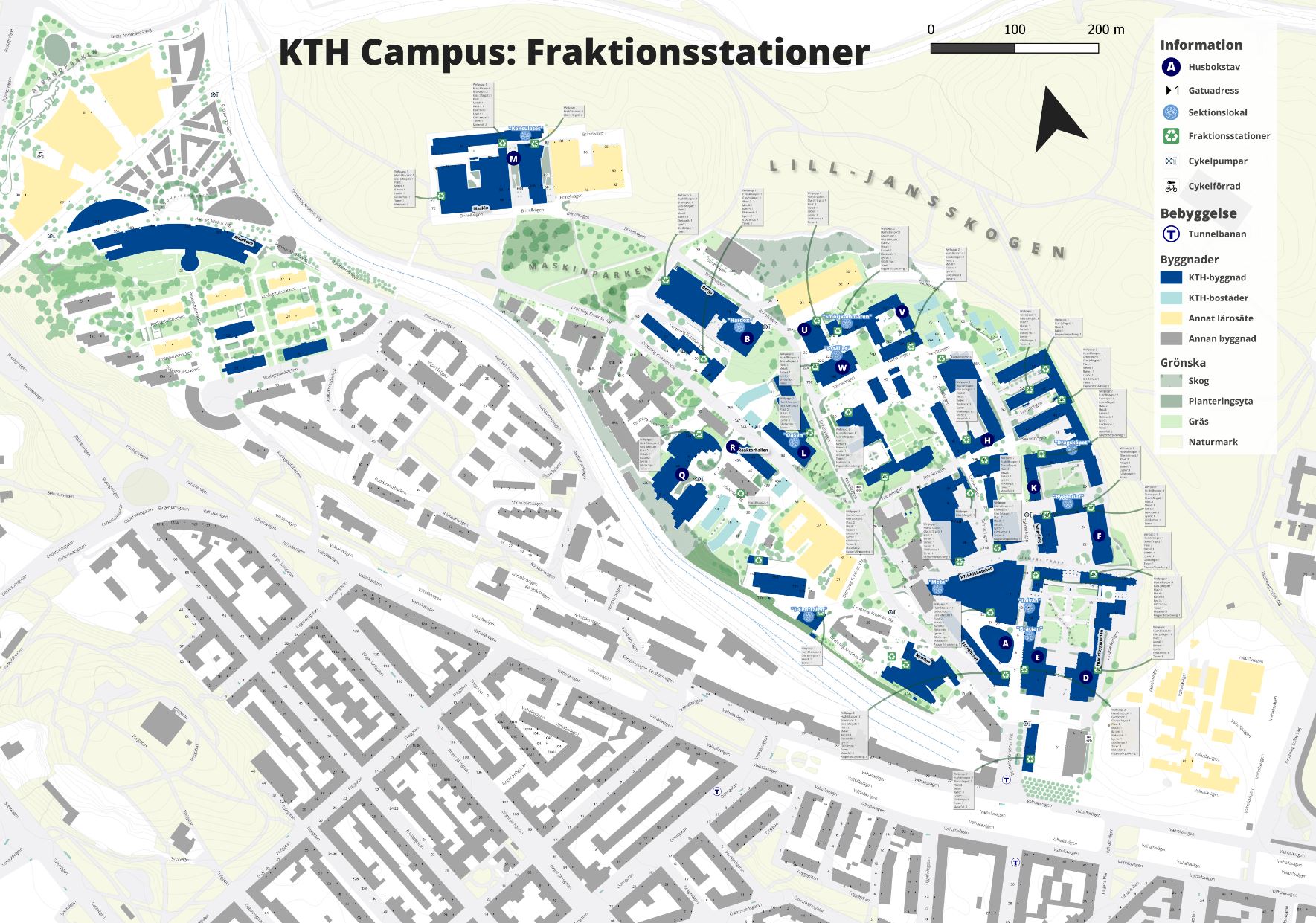Waste Disposal
Information for the disposal of waste such as paper, corrugated paper, glass and metal on campus. On the map below you can find the waste disposal, garbage and recycling room nearest to you.

KTH separates waste disposal in the following categories
Waste disposal rooms
At KTH there are three types of disposal rooms.
Waste disposal room
Primarily used for disposal of kitchen and office waste sealed in bags. If of a sufficiently big size it might be equipped with disposal for paper, corrugated paper and flourescent lights.
Recycling room
Used for recyclables such as corrugated paper, plastic, batteries, flourescent lights, printer cartridges, electronics as well as packages made of metal, plastic, paper and glass (both colored and transparent) if there is space available.
Drop-off room
Not used for general waste disposal, but for dropping of waste that the servicemen from the Property Department pickup after scheduling a visit. You can schedule a visit by contacting the Property Department or a person responsible for waste disposal at your department.
Partioning of different types of waste
General waste
Waste that is left after separating recyclables and dangerous waste and it is mostly made up of combustible waste. Should be left in the waste disposal rooms in a sealed bag.
Recyclables
Waste that can be used for the recycling of materials. Listed below is the different types of recyclables that are disposed of at KTH and how to recycle them.
Paper
Every department collects their own paper in containers that are then wheeled out to the pickup location every wednesday in an even week. Observe that exceptions can occur due to holidays and such and should be reported ahead of time by email.
Please avoid putting corrugated paper or cardboard in the paper container.
Corrugated paper
In almost every disposal room there should be mesh cages for the disposal of corrugated paper. Every building at the main campus has at least one room for the disposal of corrugated paper.
Glass
Glass should be dry and relatively clean and can be disposed of in all of our recycling rooms.
Plastic
Plastic should be dry and relatively clean and can be disposed of in all of our recycling rooms and in some disposal rooms. Soft and hard plastics are both disposed of in the same container.
Food waste
Food waste are to be disposed in special bags that are located in kitchens. You will need to contact the Property Department and Cleaning Services in order to dispose of it.
Cardboard boxes
Cardboard should be dry and relatively clean and can be disposed of in all of our recycling rooms and in some disposal rooms. You will need to contact the Property Department and Cleaning Services in order to dispose of it.
Metal
Metal should be dry and relatively clean and can be disposed of in all of our recycling rooms and in some disposal rooms.
Hazardous waste
Waste defined by the law or directives to be handled in such a way that people nor the environment comes to any harm. Listed below are the types of hazardous waste that are handled by KTH.
Chemical waste
Waste that is primarily a byproduct from laboratory work surrounding chemicals. Chemical waste that is not destroyed in the lab must be picked up by an official chemical waste company under contract with KTH. Our contractor is:
Electronic waste
Electronics are cared for by KTH and in rooms for recyclables there should mesh cages for it while bigger amounts of waste are to be collected by the Property Department. Costs for transporting waste away from KTH are paid for by KTH, while transport and handling within KTH are paid for by the department ordering it.
Scheduling pickups are to be made through the front desk for the Property Department or by the person responsible for waste at the department.
All electronic waste is defined by such waste that is electrically connected except for fridges and freezers as well as mounted appliances.
Flourescent lights, bulbs and other lights
In most waste disposal rooms there should be a container for lights of different kinds. If your department frequently goes through great amounts of flourescent lights, you can collect them in their original packaging and then contact the Property Department front desk or the person responsible for waste at the department for a pickup. Remove the protective casing first and seal the package.
Toner cartrigde
Containers for expended toner cartridges can be found in some waste disposal or recyclable rooms.
Batteries
Containers for dry-cell batteries can be found in some waste disposal or recyclable rooms.
Lead-acid batteries are to be considered as chemical waste and should be treated as such.
Fridges and freezers
Fridges and freezers contain parts that are considered as hazardous waste and should not be handled by the department. Pickup can be ordered from either the property department or an external company.
Large or bulky waste
Waste that is big, bulky or unwieldy enough to not be able to be sorted into KTH's partioning of waste, recyclables or hazardous waste. Not to be placed in disposal rooms and it is up to the department to make sure that the waste is handled in the proper way in order to minimize the risk to the environment. In some disposal rooms there are container for smaller pieces of this kind of waste.
You can always order a pickup of bulky waste from the property department.

